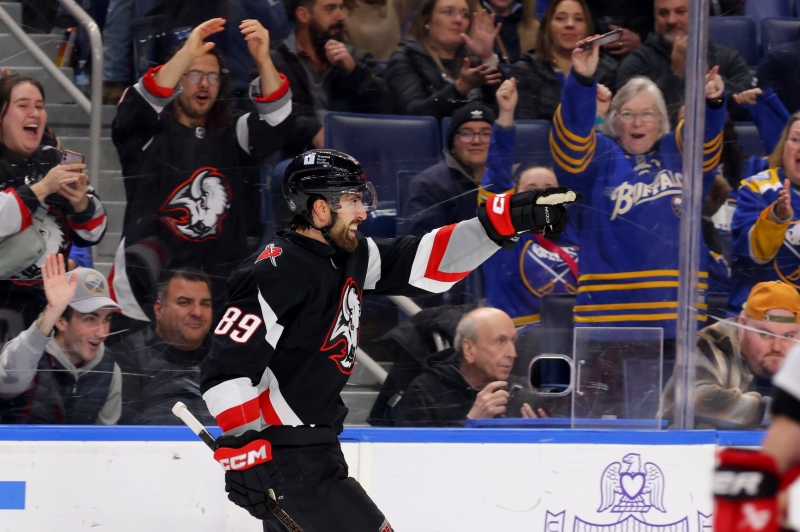The Minnesota Wild have come out of the gates cold.
Their five-on-five performance has been dreadful, whether measured by results or underlying metrics.
On the Wilderness Talk Podcast, I identified two main culprits for Minnesota’s inept five-on-five play: young defensemen and a thin forward group.
Zeev Buium and David Jiricek should improve as the season goes on, but the forward corps is more troubling. Specifically, the second line has not been competitive. Mats Zuccarello’s absence certainly plays a factor, but he could be out until early November.
Although Zuccarello’s reported injury timeline isn’t precise, it puts him on track to return around November 10. By that time, Minnesota will be at the 17-game mark — just over a fifth of the season.
Even if the Wild rebound to a stronger pace after Zuccarello’s return, those 17 games could place them on the outside of the playoff picture if they continue at this pace.
On top of that, the load-bearing pillar of Minnesota’s projected return to form is a 38-year-old coming off a two-month lower-body injury. With all due respect to Zuccarello, that’s a major risk.
An early-season trade is not out of the question. Minnesota’s roster needs forward help. And, if they wait until the trade deadline, they may find they need to add more than one piece. Let’s evaluate some trade options with moderate salary cap hits for the 2025-26 season.
NHL insider Chris Johnston recently reported a robust list of trade targets in The Athletic.
Before we dive into that list, what should the Wild seek in a new forward?
First, they’re likely seeking a winger. Marcus Johansson and Marcus Foligno have looked out of place on the second line, but Marco Rossi and Joel Eriksson Ek seem effective as Minnesota’s one-two punch at center. Assuming they bring in a winger, they need a player who drives play at five-on-five and on both sides of the ice.
High-quality shooting probably isn’t on the list, since it’s one of the most expensive “tools” to acquire, and because Minnesota already has finishers in the top six. Kirill Kaprizov, Matt Boldy, Vladimir Tarasenko, and Zuccarello (when he returns) are all talented finishers on the wing.
Lastly, Guerin must bring in a true second-line quality winger. Between Johansson and Tarasenko, it’s clear that middle-six quality forwards are miscast on the Wild’s second line. It’s time to stop asking the second-line center to drag those types of players to a second-line level and get some real help on the wing.
Bryan Rust — Wing, PIT, $5.1 MM Cap Hit
Hey, is this that Russian guy on the Penguins? I heard he wants to play here because he’s Russian, like Kaprizov.
Sorry, that’s Evgeni Malkin.
At first, Rust seems like an immediate solution to Minnesota’s needs. His cap hit is modest, so the Wild could bring in other pieces at the deadline alongside Rust. By Dom Luszczyszyn’s analytical model, Rust is a top-six quality forward who drives scoring chances and can finish his chances to boot.
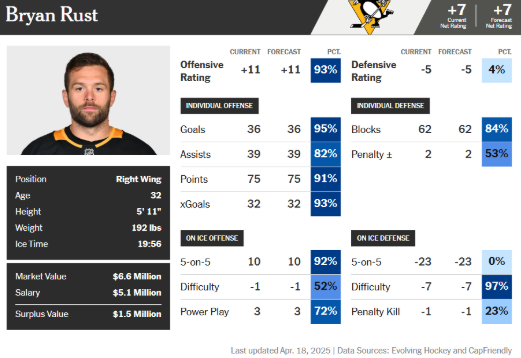
However, let’s remember what drives Minnesota’s five-on-five issues. Not only are they fighting to generate offense, but they rank 21st in expected goals against per minute (xGA/60). Struggles on the breakout aren’t surprising, given that the Wild are breaking in two new defensemen.
Adding Rust to the equation might offset all of those offensive impacts he brings.
On top of that, Rust is 33 and signed through 2027-28 — his age-36 season. Between that and his defensive issues, it’s probably best to keep looking.
Rickard Rakell — Wing, PIT, $5 MM AAV*
*After publish time, the Penguins announced Rakell will miss 6-8 weeks with a hand injury.
Two Penguins and I didn’t even make up a half-baked trade for Sidney Crosby. Never let it be said this blog is without integrity.
Rakell is precisely the type of player Minnesota needs in its top-six. He’s cheap, he drives play, and he can contribute on offense.
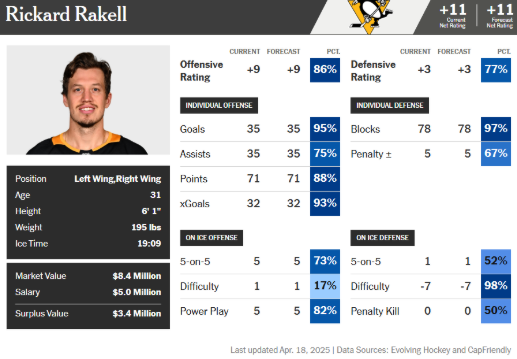
Rakell is cheaper than he should be, likely due to his age and injury history. While it’s difficult to pin down NHL injury histories, Rakell suffered an ankle injury in 2018 that kept him out for 13 games.
He’s also had recent issues with head injuries, which is certainly a concern to recur once a history starts to develop. One suspected concussion in March 2021 kept him out four games, and another reported by The Athletic in May 2022 kept him out five playoff games.
However, Rakell has been relatively healthy since then. He played 82 games in 2022-23, 70 in 2023-24, and 81 in 2024-25. It’s rare to see any NHL player miss no time over a three-season span, so this is an encouraging recent history. Rakell’s low cap hit should largely offset any concussion concerns.
On top of that, Rakell is under control through 2027-28 (his age-34 season) at that cap number with only an 8-team no-trade list. That provides Minnesota with an option to keep him in the top-6 long-term or trade him if necessary in the later years of his deal.
Alex Tuch — Wing, BUF, $4.8 MM AAV
Hey, is this that guy from Buffalo that everybody keeps talking about, even though reputable NHL reporters continue to point out that the Sabers have no interest in letting him go?
No, that’s franchise cornerstone Tage Thompson. Tuch, on the other hand, is exactly the type of player who usually heads out during a rebuild. His contract expires at the end of this season, he’s about to get paid, and he’s exiting his prime.
Tuch has many similarities to Rakell. He’s another player who’s overqualified for the role Minnesota needs to fill, but he’d likely be a one-year rental.
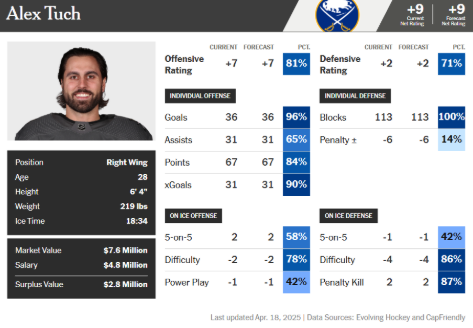
Tuch’s Achilles heel seems to be his defensive style. While he’s capable of matching up with the world’s best every night, his defensive results are mediocre in that role, and he takes a lot of penalties.
For reference, Tuch had 47 PIM last year and three fights, for an average of 16 penalties per 82 games. If all five skaters kept up Tuch’s per-minute penalty pace over a 60-minute game, they would take 249 penalties per season. That would have ranked fourth-worst in the NHL last season.
That’s especially troubling for a winger, who has fewer responsibilities in defensive transition, defensive zone corners, and at the defensive netfront. Three places where players are most likely to get into a compromised position and take a penalty. The Wild could mitigate this problem by sheltering his role compared to his current assignments in Buffalo.
While Tuch’s penalty kill numbers would be a great fit on the Wild, he can’t kill off his own penalties. Despite that weakness, Tuch would be a versatile piece who can kill penalties and play a shutdown role or serve as a top-six weapon.
JG Pageau — Center, NYI, $5 MM AAV
Hey, is this that guy from New York? I heard he wants to play here because he’s Russian, like Kaprizov.
Sorry, that’s Artemi Panarin, who plays for the Rangers. Pageau is a bit boring by comparison, but he’s another great fit for Minnesota’s needs.
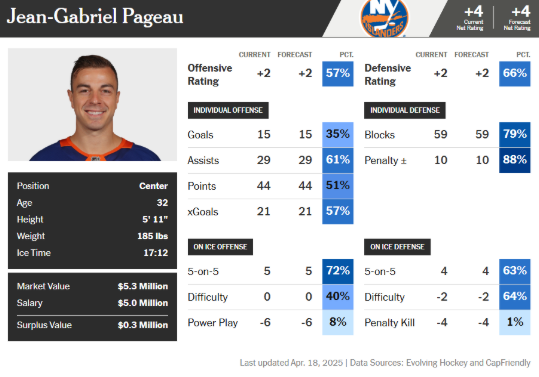
Pageau is a bit of an odd fit with the Wild as a center on a team that needs help at wing, but he checks the initial boxes of driving play and performing at a true second-line level.
His faceoff performance last year was also exceptional, with a 59.6% win rate. While that may have been sheltered a bit behind elite lefty Bo Horvat, Pageau took more faceoffs than any right-handed player on the Islanders last year.
Adding Pageau at center would allow the Wild to bump Danila Yurov to the wing when Pageau fills out the bottom-six centers. They could also experiment with moving Pageau to the wing as a play-driving second-liner.
With his $5 million cap hit, Pageau likely makes sense as one of two or three smaller trade deadline additions, which brings me to my final point: Minnesota may be best suited to acquiring more than one player at the deadline in a smaller trade, rather than trading for one major player such as Panarin.
Adding Panarin and Zuccarello would make for an impressive top-six, but it does little to fill out Minnesota’s depth. On the other hand, adding two of Pagueau, Tuch, and Rakell has the makings of a dynamic top-nine forward corps upon Zuccarello’s return. By acquiring two play-driving forwards, the Wild can put Tarasenko and Zuccarello on separate, self-sustaining lines.
Compare that to a roster that only adds Panarin. Kaprizov, Boldy, and Panarin will make an effective top-six when centered by Eriksson Ek and Rossi. However, one of Tarasenko or Zuccarello would be left orphaned in a bottom-six group that doesn’t have much punch.
Supplementing that bottom six with an extra second-line forward should be sufficient, given what Kaprizov and Boldy were able to do against the Vegas Golden Knights in the 2025 playoffs. It also more closely matches the Florida Panthers’ roster strategy of an effective top line but dynamite depth.
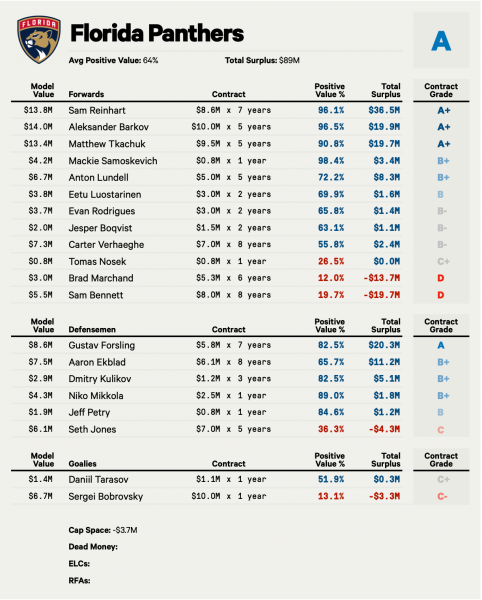
Perhaps more importantly, a souped-up third-line scoring role led to the best hockey Tarasenko has played in the past three seasons.
However, to enact that strategy, Minnesota still needs to accrue enough cap space to afford more than one player. Right now, their five-on-five game is lacking all over the ice. Without positive regression coming soon, they may not be able to wait until March 6. The problem is that if they acquire one of these contracts before the trade deadline, they won’t accrue enough cap space to fit another addition.
Minnesota has options at the trade deadline. The question now is how soon they have to push that button.
